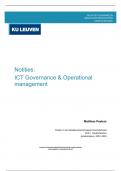Samenvatting
Samenvatting - ICT Governance & Operations Management (B-KUL-HMH46A)
- Instelling
- Katholieke Universiteit Leuven (KU Leuven)
Samenvatting van het vak ICT Governance and Operational Management, gedoceerd door Irene Vanderfeesten en Yves Wautelet aan KU Leuven, Academiejaar .
[Meer zien]




